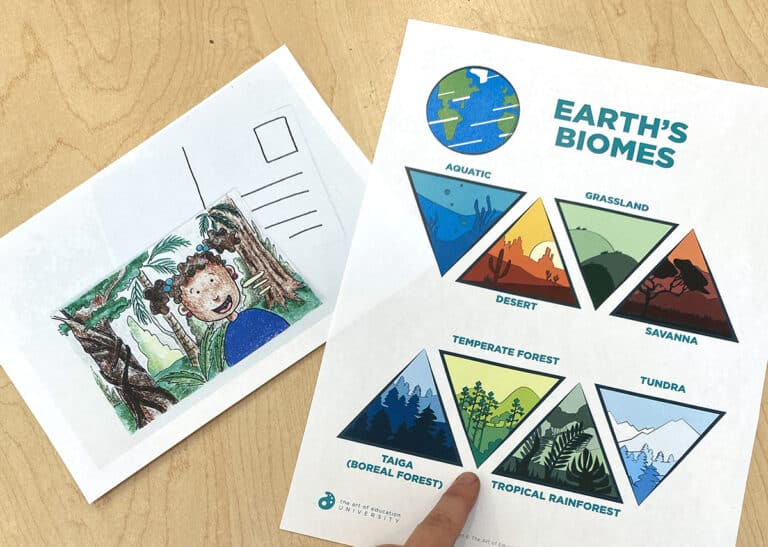When I first heard about FLEX as a high school art teacher, I turned up my nose. I don’t need any packaged curriculum! What could someone else’s curriculum offer me, anyway? They don’t know my students and my needs!
Then I took a closer look.
Writing curriculum is in our veins. We know the lessons we want to scaffold and how to scaffold them. We geek out when coming up with new and exciting ideas for our students to explore.
Even so, sometimes writing lessons can be a drag. We are stretched so thin! Between classroom and materials management, art show season, managing extra stress at home, and all the other (and often unique) responsibilities, lesson planning can be a chore. Regardless of how you come up with lessons, FLEX has options to meet your specific lesson planning needs.

So, what can FLEX really offer us? Why, FLEX-ibility, of course!
All puns aside, there is a lot of versatility in how you can use FLEX (and I’m pretty judgy!) As we explore these options, reflect on which would be most beneficial to your lesson planning process.
Here are three ways FLEX is FLEX-ible:
- You don’t have to reinvent the wheel.
- You can use the curriculum as a jumping-off point.
- You can use any of the resources and videos to supplement a lesson you have already created.
1. Use FLEX “as-is.”
FLEX lessons are different from others because they are aligned to national and most state standards. Because AOEU has done the research and alignment on the front end, the lessons are solid and will support learning goals.
Anytime we use “someone else’s” lesson, it’s important to consider how it fits within our own scope and sequence and meets students’ needs. Perhaps your students are exploring tints and shades with acrylics. There are several full FLEX collections (comprised of six lessons each) that focus on acrylic paints and color mixing. From flower paintings to clay sculptures, there are many products students can create. Choose which product and lesson best fit your curriculum.
Once you’ve chosen your FLEX lesson, decide what minor adjustments are needed. For example, your classroom supplies may be limited, or the timeline of activities might need a tweak. FLEX lessons give step-by-step instructions with enough room for you to envision how they will fit directly into your unique situation.
2. Use FLEX to spark other lesson ideas.
Where do you go when you are stuck in a lesson rut? Maybe you research artists for inspiration or peek at another amazing teacher’s Instagram account. Let FLEX help get those ideas flowing!
FLEX lessons are inspired by historical and contemporary artists, a wide (and ever-expanding) range of media, relevant topics, overarching themes, and targeted techniques. As FLEX continues to add lessons each month, you can start from just about anywhere.
Pull a FLEX lesson to use as a framework or starting point. Let’s take a look at the lesson Music in the Round. This lesson investigates the role musicals can have when discussing social, cultural, and historical events. In lieu of a traditional canvas, students use a disposable coffee cup with a removable sleeve as their artmaking surface. Students can remove the sleeve to reveal patterns and rhythms.
As you peruse the lesson, ask yourself how you can add variations to better engage your set of students. Perhaps instead of musicals, students can connect with their current favorite songs and how those lyrics tell a story. Or students can investigate different types of music from around the world and represent cultural relationships on the outside of the cup. Consider a full installation experience by playing short clips of music with each corresponding cup on display.
A more comprehensive lesson can kickstart an idea for a shorter, more lighthearted activity. Students can play Exquisite corpse with a “twist”! Consider how students can rotate the sleeve and match up different tops and bottoms. They can collaborate by sharing and swapping sleeves and lids.
A conceptual layer on identity is another idea. How might students explore inside, outside, and what’s covered up?
For example, start your lesson by asking the following exploratory questions:
- What could the cup contain?
- What could be revealed inside the cup when the coffee empties?
- How do we “dress” on the outside and “cover up” the reality underneath (the coffee sleeve)?
From one awesome FLEX lesson (that is fabulous as-is), ideas can blossom and branch out, sparking even more lessons to add to your cache.
3. Use FLEX as a resource gold mine.
Maybe you have a solid curriculum already and think you don’t need anything. If that’s you, do you know about all of the amazing resources available through FLEX? Most resources are anchored to a lesson, but you can review resources through a filter. From videos and assessments to worksheets and reference lists, if you’re looking to supplement your own curriculum, look no further!
Below are some examples of FLEX resources you can plug into any lesson:
- Looking to change up your critique process? There are 10+ different formats available in FLEX to try out.
- Need some ideas for the perfect rubric? Check out the Plug N’ Play rubric as a foundational assessment tool.
- Maybe you’re struggling with how to write an artist statement. There are mini-templates and checklists to help you get started.
- Perhaps you could use a quick worksheet to help students mix paints? Student-facing resources will stop you from reinventing the wheel and save a lot of time.
- Looking for a list of twenty digital artists? Or maybe just one specific mixed-media artist? You can search for that, too.
- Need a succinct video all about printmaking? The videos are not only informational but soothing to listen to. (Thanks, Tim Bogatz!)
- Looking for a one-page explanation of CMYK versus RGB color? Teacher reference sheets help you break down big concepts into student-friendly supports.
Even if some resources are specific to a FLEX lesson, you can easily modify and adjust without starting from scratch. The search functions and tabs help you find exactly what you’re looking for right when you need it.
Take some time to dig into FLEX. You will quickly discover how incredible this curriculum really is. When lessons feel stale, you need a break, or you are looking to supplement your curriculum, add FLEX lessons and resources. Be sure to check out the Implementation page. It has many resources, such as how to use FLEX with your Learning Management System, scope and sequences, and How to Get FLEX Curriculum in Your District!
What questions do you have about FLEX?
What is your favorite part of the FLEX curriculum?
How do you use FLEX in your lesson planning?
Magazine articles and podcasts are opinions of professional education contributors and do not necessarily represent the position of the Art of Education University (AOEU) or its academic offerings. Contributors use terms in the way they are most often talked about in the scope of their educational experiences.








